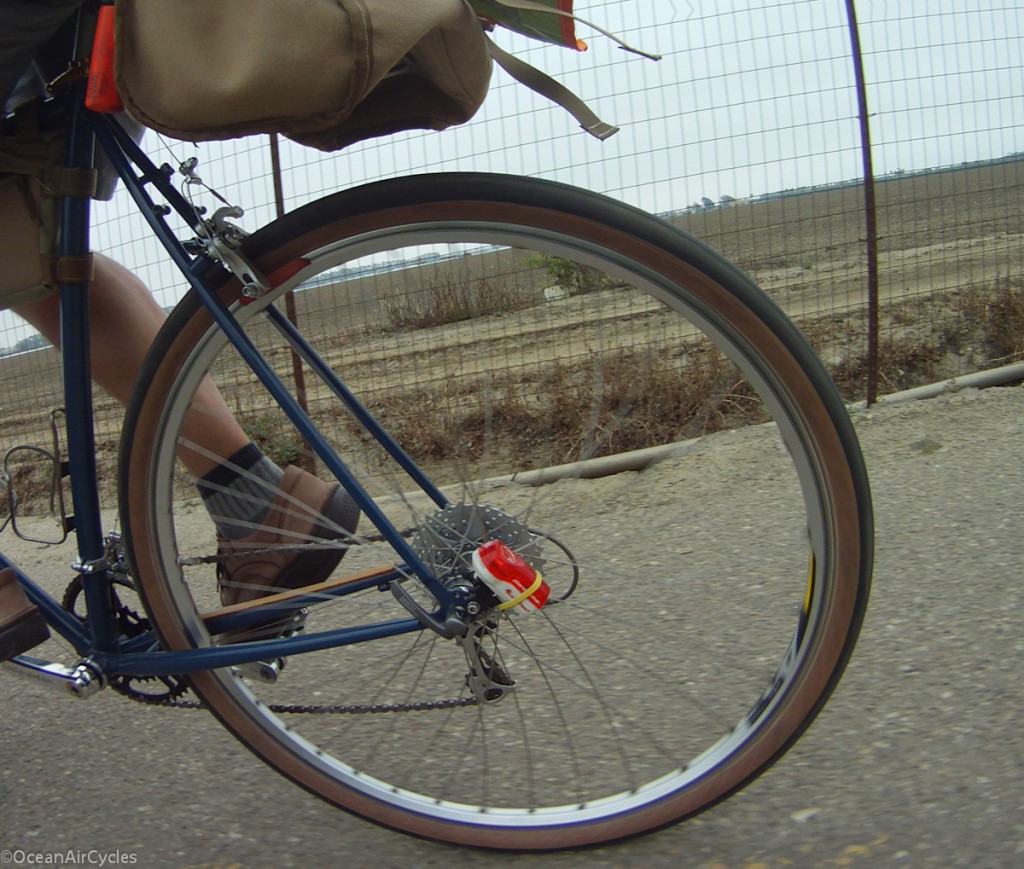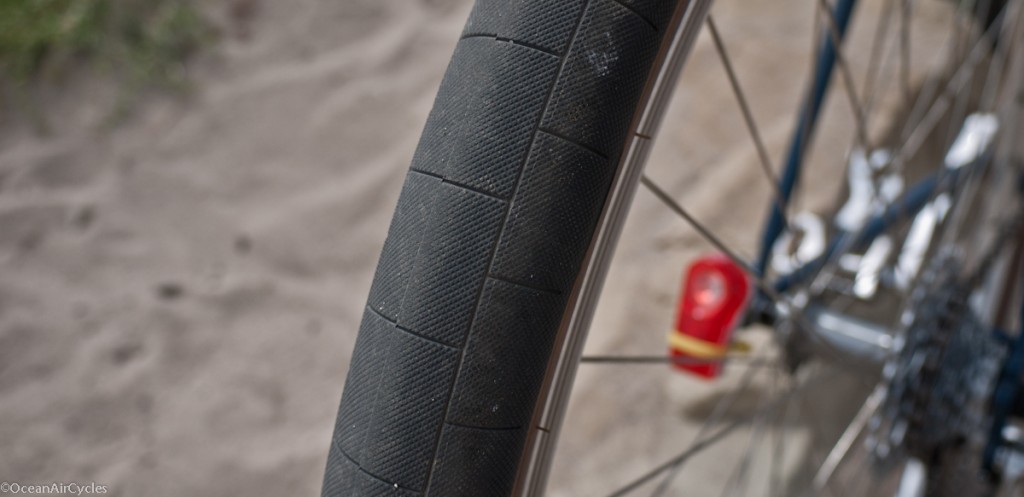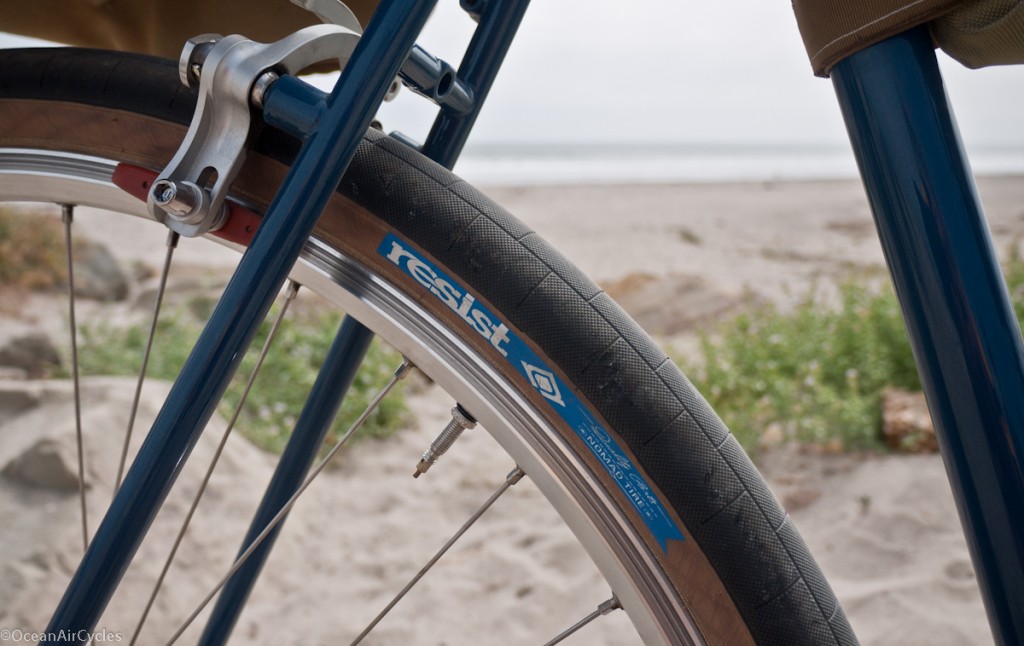I have been riding the Resist Nomad 700×42 for almost 6 weeks and almost 1000 miles, and feel comfortable sharing my initial impressions of the tires. Over the years I have come to appreciate the ride quality of fat light weight tires on the road. Experience has proved for me at least that you can get the comfort and speed, rolling over all of the little stuff and most of the big stuff too without having to give up speed and acceleration. The catch in the 700c size is a limited selection of true light weight performance tires wider than 32mm.
 While the selection for tires like this is improving, most have a more pronounced knobby tread. I was excited to see the Resist Nomad hit the market a little over a year ago. These tires are primarily designed for the freestyle urban scene. The fact that they meet the demands of the mixed terrain / fat tired road bike crowd was a bit of a surprise for Resist. The catch for me at the time was not having a bike that would fit tires this wide. Rambler No.1 then entered stage left. My Rambler is purpose-built around tires this wide. While my production samples were under way I was in contact with Resist to get some samples in my hands. Currently these are the lightest 700x42mm tire on the market that I know of.
While the selection for tires like this is improving, most have a more pronounced knobby tread. I was excited to see the Resist Nomad hit the market a little over a year ago. These tires are primarily designed for the freestyle urban scene. The fact that they meet the demands of the mixed terrain / fat tired road bike crowd was a bit of a surprise for Resist. The catch for me at the time was not having a bike that would fit tires this wide. Rambler No.1 then entered stage left. My Rambler is purpose-built around tires this wide. While my production samples were under way I was in contact with Resist to get some samples in my hands. Currently these are the lightest 700x42mm tire on the market that I know of.
Out of the box I was pretty impressed. I have samples in both the skin wall and black wall. The skin walled tires average 530g while the black walls average 560g. Both currently are only available with a wire bead. While not a svelte race tire, the weight is quite reasonable when you consider that the popular 650bx42mm Grand Bois Hetre’ is roughly 430g with a folding bead. The width is a rue 42mm. The tread is a semi slick with micro pyramids broken up with a larger square grid. The street price on these tires is around $30.
Enough with the stats, the ride is what really matters, and it has been great. Initially they were a little bit loud, a sort of hum from the tread against the road, but that quickly faded as the tire wore in a bit. I have kept the pressure between 40-50 psi for my combined rider/load/bike weight in the 240lb ball park. Handling has been superb. They get a little bit of roll or dive at the rim if I let the pressures drop below 35psi. The road buzz from our currently terrible roads is gone. It really is like riding on pillows. Average times and speeds, about 18mph cruising, are on par with my previous data I collected riding Jack Brown greens or a variety of 28mm tires on other bikes. Cornering and grip in dry weather is fantastic. I am able to carry more speed through turns, ride through rough patches and hold more consistent lines than previously possible on narrower tires. Unfortunately (or Fortunately) we are a bit spoiled with a lack of rain in the SoCal basin and I have not had a chance to push these in the wet. On fire roads and the trails they have held their own well. While obviously not as grippy as a true MTB tire, the added volume and contact patch has been welcome in easing the attention I need to pay to my line with the “skinny” 35mm tires I have been on in the last couple of years. The Nomads help to bridge the gap between true underbiking and a knobby tire.
The build quality is what you would likely expect for a tire at this price point. For $30 retail you can not expect the level of detail and finish that has been coming out of the Panaracer Japan group for some of the other popular boutique tires. As you can see in the picture the two sides of the mold were not well aligned. The casing and rubber around the bead on the skin walls is a little thin. One of my samples has a short tear from being a bit heavy-handed with a tire lever, and that tire is now out of service. I have only had one flat to date. It was in the rear and caused by a thin truck tire wire. Considering the amount of glass and debris on out roads this is pretty good. I tend to pick up flats or slow leaks like this every couple of months. Thus a single flat early on is just that, a flat, and marginally an indicator of long-term performance.
Bottom line, these look to be a great tire for the price. I will likely run them for a long time, and look forward to a long-term follow-up review. If your bike has the room to fit these tires I would not hesitate to pick up a pair. I am happy enough with them that I may be adding them to the storefront in the next few weeks. There are a bunch of variables in that equation, but I know I will stock them eventually.


Visually, they remind me of Primo Comets. Although they have no “edges” in the tread.
Similar to the comet in many ways, but the overall cross section is a little more round. We actually have one bike in the stable that is still running a set of 26″x42 comets. They are/were very nice tires IMO for dry weather. In the rain was a whole different story with the comet. Not that I want rain, but I do need to put on some wet miles with the Nomads.
Glad they worked out for you Rob. I had the 35’s ( ~33mm) on the Coho for 400 miles or so. I just switched back to Jack Browns as mine seem to wander a bit. Fast and great cornering, but they don’t track a straight line as well as Pasela’s or JB’s. Maybe I got a bad tire?
While I think the overall QC on these tires has room for improvement, For the price though I do not think there is much room to complain. The only other tire this cheep and still light-ish is the Pasella. Its price is held own by the shear volume of tires made. The Nomad is still relatively new, and a niche tire as well, and the only thing wider than 38mm. For $25-30 a tire something has to give. It took a bit of patience to get it seated perfectly the first time, but after some miles they settled in. While not perfect they roll fairly true.
For me the real take away is how well a light 700x42mm tire can perform. The question of the year is if the market would bear a high quality version at a higher price. I would be willing to do the legwork if I thought I could sell a couple hundred. Based on my research, that really is the minimum to break even on the mold costs with Panaracer’s Japanese production. It is a bit ironic that 6 years ago the niche market was longing for the Hetre and Pari-moto, and now I want to bring that style of tire to the 700c world. With all the 700c choices you would think that there could be something in the 42mm wide and sub 500g catagory.
It will be interesting to see how many miles they last. One data point is the Schwalbe Marathon Supremes that I’ve been using for quite a while. My first set of 40 mm has been on for 6,300 miles. The rear is about gone & will be replaced in the next few weeks. The front still has lots of life left. This pair was purchased used from Dustin but had not seen a lot of use. Schwalbe claims 495 grams for the folding bead & IIRC now over $70 per tire. I’ve had one flat, caused by a big honkin’ roofing nail. IMHO, a market exists for a $35-$50 tire in the sub 600 gram weight and the 40-45 mm width x 700c that is general purpose for touring, moderate off-roading such as Sulphur Mtn, commuting, etc. No knobs req’d nor super lite sidewalls for the “suple ride” set.
dougP
My gut feeling is that these will do about as good as Jack Browns. The rubber is a bit thinner feeling than the JB greens, but the contact patch is larger. In my experience as the contact patch gets bigger the wear slows down a bit. Hence tires can be made as thin as the Pari-Moto and still go for a couple thousand miles. I get about 3000 miles out of a rear JB green, and likewise am interested to see how these tires play out in the long run.
I have found that the biggest gain with my Schwalbe tires is longevity. You give up a bit of the perceived suppleness and rolling resistance for wear, flat protection is always a wash for me. Even in an area that seems to be paved with broken glass, flats still occur with enough randomness that it is hard to credit the tire build alone. I do believe that running wider tires at low pressure allows you to roll over more pointy and sharp things without puncture. Rubber compound and then extra belting play secondary and supporting roles. Most of my flats come from things like your roofing nail, and no kevlar belt is really going to stop that. it all boils down to $$ per mile in the long run
I hear you on the tire build specs. I wish there was a way to better collect and process real data to compare the rate of failure, sidewall, to the thickness. I value you opinions built on thousands of miles experience, but would love to get you out on a flexible light bike with supple tires for a few weeks here in Southern Cal. Not that you would ever need to ditch the Atlantis, they really are great bikes, but I think you would appreciate the difference. More-so than speed gains, I think you would appreciate the further faster with less effort aspects. Distilling that into fresher legs and less need for breaks. You can pull off most of the same riding without being as tired at the end. At least For me the difference is real and noticeable.
I too sliced the sidewall of a 35mm Nomad by pulling the front tire out of the fork. Apparently my popular brand brick-red brake pads have sharp edges 🙁 Be careful!